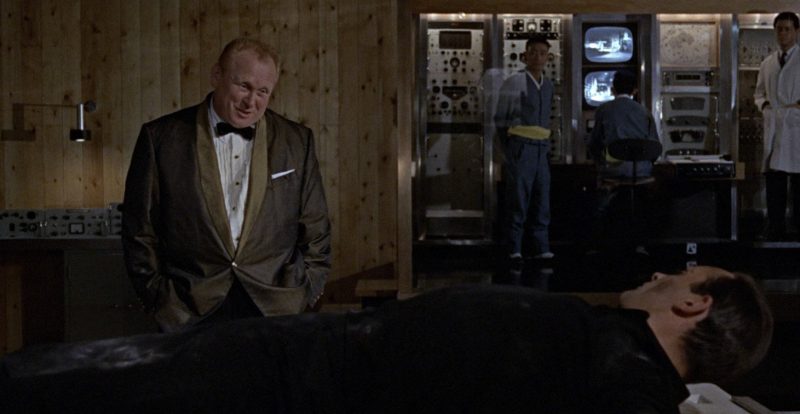Sooner or later, nearly all James Bond fans gets asked to identify their favorite Bond actor. For many, it’s the actor playing the character in the first Bond movie that they saw. When I picture James Bond, I see Roger Moore. My first Bond experience was at a drive-in theater in 1973 to see Live and Let Die. I didn’t see Sean Connery in a Bond film until nearly a decade later, by which time I’d seen Moore in a total of four Bond films. However, when it comes to who fans’ favorite Bond villains are, things seem to get much more interesting.
I host several movie events each year, and Bond films come up all of the time. Over the years, I’ve taken my own unscientific polls of everyone’s favorite villain. Dr. No comes up now and again. Stromberg (The Spy Who Loved Me) gets a mention here and there, and Le Chiffre (Casino Royale) seems to pop up from younger fans. Two names come up more than any other, with one edging out the other. The runner-up is Ernst Stavro Blofeld, played by several actors starting in 1963’s From Russia with Love, where two different actors portrayed him — one providing the voice and one providing the visual of just his hands and the back of his head. Blofeld tops many Bond villain lists simply because of his proclivity for appearing in so many films. He’s the Moriarty to Bond’s Sherlock Holmes. No shock there.
What was originally a surprise is that the villain whose name comes up most often in my events is Auric Goldfinger from 1964’s eponymously named Goldfinger. When I ask my friends why they choose him, the response generally boils down to a simple reality: Auric Goldfinger doesn’t need a physical ailment to convey his megalomania. He’s just clearly, purely, fully evil.
My impromptu polling has colored my view of Bond villains to the point of becoming critical of the way that Bond producers handicap their bad guys. In 2021’s No Time To Die, there are three main antagonists who each have some terrible affliction branding them as villains. It’s as if the producers think that the audience needs these obvious visual aids to decipher the difference between good and evil characters. No Time To Die stamps Blofeld (Christoph Waltz) with a missing right eye and a nasty scar. Primo (Dali Benssalah) sports a snazzy, multipurpose, glass left eye that’s clearly oversized (just so that you don’t miss it, I’m guessing), and Lyutsifer Safin (Rami Malek) lives with an entire face — and I assume body — disfigured by a nasty nerve agent.

Damaged eyes seem to be a personal favorite of the producers and shared by Bond’s creator Ian Fleming. A cursory look finds no less than 10 villains with eye issues. The rogues of Fleming’s novels are often grotesque in a list of ways that could leave a mortician with a queasy stomach. Fleming grew up at the dawn of cinema in an era where moviegoers distanced themselves from anything viewed as abnormal. That combination pretty much guaranteed that, on-screen and off, villains would be portrayed and described as anything but commonplace. Those days are now long behind us, and Bond’s producers haven’t grasped that yet. Outside of Disney movies, the antagonists of most of today’s blockbusters are just like the rest of us, but bad.
The takeaway for me is that the most effective — and, thus, best — villain is the one whom the audience never sees coming. Nothing is scarier than a psychopath who looks like your average neighbor, and that’s why Goldfinger works so well. Hannibal Lecter doesn’t need a menancing prosthetic to make your hair stand on end. He’d fit right in at your local book club meeting… right up to the snack break. It’s one of the core reasons why Tony Soprano (The Sopranos) and Walter White (Breaking Bad) drew so many fans each week.
Sure, quite a few Bond baddies sport no outward signs of internal strife, but most of them are written as so over-the-top as to be laughable. I’m looking at you, Raoul Silva (Skyfall). Personally, I find myself pulled right out of the plot of new Bond films because of the distraction of whatever outrageous affliction the antagonist is saddled with. I literally missed a few lines of Safin’s opening dialogue because I was too busy trying to figure out what the hell happened to his face. It’s much more satisfying to slowly piece together tidbits of telling dialogue and actions before finally realizing that you’re dealing with a lunatic.
Such props are not only distracting, but also insulting. Today’s audiences are far more sophisticated. They’ve been exposed to decades of stories and no longer need to be spoon-fed cues to tell them who’s who. Most concerning is that this also reinforces the woefully misguided idea that a person’s outward appearance reflects who they are inside. If history teaches us anything, it’s that, if such people are evil, it’s likely that they ended up that way as a by-product of the evil way that people reacted to and treated them throughout their lives.
If I could ask for one thing in the next generation of Bond films, it would be to spend more time effectively masking the villains’ disturbing personalities and less time masking their faces.
